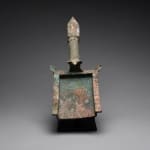Bronze Mahta Incense Shovel, 1st Century CE - 2nd Century CE
Bronze
height 29.2 cm
height 11 1/2 in
height 11 1/2 in
FZ.218
Further images
In the Temple of Jerusalem and in synagogues throughout the ancient world, the fragrant smoke of incense filled the air. The high priest burned this aromatic blend of spices and...
In the Temple of Jerusalem and in synagogues throughout the ancient world, the fragrant smoke of incense filled the air. The high priest burned this aromatic blend of spices and gums on a special altar before the Holy of Holies. The smoke was intended to purify the air of the sanctuary and to please the deity. A costly offering, incense was considered the worthy gift of princes and heads of state. It also carried great spiritual significance hence the saying, ‘Let my prayer be set forth before thee as incense, and the lifting up of my hands as the evening sacrifice,’ (Psalms 141:2). The mahta, or incense shovel, was employed in the ritual of burning and for removing the ashes afterwards. This splendid example, free from graven images, was almost certainly used in a synagogue of the Roman Period. The handle is of column-form, decorated with a Corinthian capital.
Similar bronze incense shovels were discovered in the ‘Cave of the Letters’ in the Dead Sea area in the 1960s. This site was so-named because it was found to contain a cache of letters from Simon Bar Kochbar, leader of the Jewish Revolt against Rome, 132-135 CE. This was one of the most significant archaeological discoveries of the last century and is illuminating in this instance because it has helped scholars to date these shovels between the 1st-2nd Centuries CE. After the destruction of the Temple in 70 CE mahtas acquired great symbolic value. They are sometimes illustrated in Late Roman and Byzantine period mosaics.
For a comparable published shovel see, J. Goodnick Westenholz ed., ‘Three Faces of Monotheism,’ (Bible Lands Museum, Jerusalem, 2007), pp. 58-59, No. 17.
Similar bronze incense shovels were discovered in the ‘Cave of the Letters’ in the Dead Sea area in the 1960s. This site was so-named because it was found to contain a cache of letters from Simon Bar Kochbar, leader of the Jewish Revolt against Rome, 132-135 CE. This was one of the most significant archaeological discoveries of the last century and is illuminating in this instance because it has helped scholars to date these shovels between the 1st-2nd Centuries CE. After the destruction of the Temple in 70 CE mahtas acquired great symbolic value. They are sometimes illustrated in Late Roman and Byzantine period mosaics.
For a comparable published shovel see, J. Goodnick Westenholz ed., ‘Three Faces of Monotheism,’ (Bible Lands Museum, Jerusalem, 2007), pp. 58-59, No. 17.
Literature
V12







